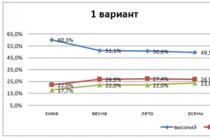Toolkit for the operation of large information systems on the platform 1C: Enterprise 8
This tutorial on the operation of large information systems on the platform "1C: Enterprise 8" outlines the key points related to setting up software for effective work systems based on the 1C:Enterprise platform, basic methods for investigating availability and performance problems are described, and issues of organizing operation are considered. The book contains theoretical information about the organization of operation and describes practical methods, provides an analysis of the settings of various components of the information system. In addition, basic methods for localizing and investigating problems are described, and examples of solving specific applied problems of operation are given.
The manual is intended for students of the course "1C: Operation of large information systems", as well as for specialists involved in the operation of information systems built using the technological platform "1C: Enterprise". It is recommended as a methodological material in preparation for certification "1C: Exploiter of large information systems". This material serves as a significant methodological addition to the materials set forth in the documentation for the ITS, and others on the topic of operation. The manual is designed to systematize and streamline the practical operating skills already available to the reader, to provide them with the methods worked out by the specialists of the 1C company on large corporate implementations.
The authors suggest that the manual will be used in daily work operators and administrators of information systems. And they expect that part of the material will be used as checklists, which make sense to deviate from only when you understand “why it doesn’t suit us”. It makes sense to try to execute the proposed examples of commands, queries and scripts, learn how to use them. These examples have repeatedly saved time when investigating technological problems. The authors also believe that specialists in the field of operation, applying the acquired knowledge, will be able to increase their effectiveness in ensuring the technological quality of large information systems. The resulting set of tools and knowledge will help specialists quickly collect the necessary information about emerging problems for their prompt elimination.
In preparing the materials, the practical experience of the teams operating large information systems on the projects of the Centers of Competence for Technological Issues of the 1C Company (CKTP) was used.
Publishing house - 1C-Publishing
Year of publication - 2017
The experience of implementing applied solutions on the 1C:Enterprise 8 platform shows that the system allows solving problems of varying degrees of complexity - from automating one workplace to creating enterprise-wide information systems.
At the same time, the introduction of a large information system makes increased requirements compared to a small or medium implementation. An enterprise-wide information system must provide acceptable performance in conditions of simultaneous and intensive work a large number users who use the same information and hardware resources in a competitive mode. At the same time, both the hardware and software parts of the system operate under heavy load.
Performance and scalability of the 1C:Enterprise 8 platform and typical application solutions
1C:Enterprise 8 is a modern technological platform designed for high loads and simultaneous work of a large number of users. The ongoing load tests and the experience of real implementations show that the 1C:Enterprise 8 platform and standard applied solutions can be successfully used to create enterprise-wide information systems.
Performance and scalability in real implementations
1C Company regularly monitors implementations and conducts user surveys to assess their satisfaction with system performance. The experience of using the system in real implementations shows that it successfully copes with the tasks of creating enterprise-wide information systems.
- Sales and Implementation Monitor "1C: Manufacturing Enterprise Management 8"
Technological issues of large implementations
A major implementation presents technical specialists with complex tasks that require a special approach and special knowledge. The experience of analyzing the technological issues of large implementations shows that with the right approach, it is possible to solve any emerging issues and achieve good performance system performance and scalability. At the same time, a large-scale implementation imposes increased requirements on the qualifications of technical specialists.
Firm "1C" sets itself the task of improving the technological quality of large implementations on the platform 1C: Enterprise 8. To this end:
Technologies and tools
Architectural and technological solutions in the platform
Architectural and technological solutions implemented in 1C:Enterprise 8 are designed for the simultaneous operation of a large number of users and the achievement of high system performance and scalability:
- Client-Server Architecture
- Server cluster
- Building distributed infobases
- Managing Data Locks in a Transaction
- Integration tools with other systems
- Background job mechanism
- Request mechanism
- Client-server administration utility
- Registration log
- Technology magazine
- Measuring performance with the debugger
Enterprise Toolkit
1C: Exploiter of large information systems
During the operation of information systems, one of the main tasks is to prevent possible incidents in order to eliminate the occurrence of problems in the work area. The basis of the quality work of the system is a properly built process of its operation.
Operation includes the following sections:
- Task scheduling.
- Administration:
- working area;
- preparatory zone;
- development zones.
- Operation of the working area.
- Development:
- necessary tools;
- refinement of existing mechanisms;
The tasks of operating the working area include:
- Monitoring and maintenance of the information system:
- monitoring of the entire working area, development of monitoring;
- solution of problems identified by monitoring data;
- system management, elimination of possible bottlenecks according to monitoring data.
- Implementation of scheduled tasks for the maintenance of the information system:
- the introduction of new units and their support with the start of users in the system.
- Duty and "fire" work:
- making critical corrections to restore work.
- Organization of the first line of technical support:
- analysis and classification of appeals;
- the most prompt response to user requests;
- interaction with users;
- transfer of collected and structured information about the problem of the second line of technical support.
- Organization of the second line of technical support:
- analysis of appeals and solution of technological problems;
- classification of problems.
- Testing and updating to new versions of solutions without compromising quality.
- Audit of additional reports and processing.
- Automation of repetitive tasks.
Administration tasks include:
- Deployment, configuration and maintenance of equipment.
- Configuring the virtualization environment.
- Network configuration.
- Configuring a 1C server cluster.
- DBMS configuration.
- Regular backup creation, storage and deployment of backups.
- Ensuring work with licenses, keys, certificates.
- Software updates.
- Deployment of new scale units.
- Automation of repetitive tasks.
- Setting up monitoring when making changes to system components.
Development tasks include:
- Commissioning of new information bases and areas:
- finalization of configurations to the possibility of transition to the service.
- Development of analytical reports.
- Statistics extension.
- Development of mechanisms for the development of the service.
- Development of integration mechanisms.
Firm "1C" organized a preparatory course for the "Operation of large information systems" competence. The course provides an opportunity to form a holistic view of the competence of "information systems exploiter", to understand the technological proper organization operation of a large information system and construction of the operation process, configuration and administration of the information system, deployment of monitoring and control settings for the technological quality of the operation of a large system.
Firm "1C" conducts certification of technical specialists in the competence "1C: Exploiter". The exam involves confirmation of the competence of a specialist as a qualified engineer for the operation of large information systems based on 1C solutions.
Operational projects
Firm "1C" provides services for the supervision of joint projects aimed at organizing and building the operation of a large information system.
All works are carried out with the participation of specialists of the Firm "1C", who:
- Provide all the necessary methods and tools;
- Control the correctness of the adopted technical solutions;
- Provide prompt assistance in solving complex technical problems;
- Control the progress of work and the results obtained.
To date, the management of most enterprises is increasingly thinking about business automation, whether it is a small or large company.
One of the leaders in software products Russian market for automating business processes are the products of the company "1C". Firm "1C" provides a comprehensive automated system, as a rule, being typical solutions. It should be noted that standard solutions are universal, and most of the business processes and principles of operation of enterprises are already taken into account in them. However, the nature of the work large companies goes beyond functionality standard solution provided by 1C. Along with this fact, the partners of the 1C company provide adapted 1C software products to the needs of the company.
Main part
1 The main difficulties when working with large companies And
Projects related to the development and implementation of information systems in large manufacturing companies are among the most complex projects. Features of the work of manufacturing companies does not allow the use of standard implementation projects. The Contractor performs a detailed survey of the Customer's business processes, forms the terms of reference and coordinates it with the Customer. Also, the Contractor is fully responsible for the project, in case of failure to complete it on time, the Contractor receives the agreed penalties. In turn, the Customer does not bear any risks.
Companies 1C: Franchisees who received an order from large manufacturing enterprises for the implementation of the implementation project, basically face the same problems. Usually, the Customer does not understand the project objectives that should lead to the fulfillment of the project objectives. Either the level of qualification of the company's employees is not high enough, it is also a frequent situation when the company's employees continue to frantically cling to the old system, thereby postponing the launch of a new automation system.
2 Workflow automation
Automation electronic document management is the most important and decisive point for implementation. Document management on 1C allows you to formalize the logic of the business process: who, how and in what sequence should work with the documentation. A clear delineation of responsibilities very often allows you to put things in order as a whole in the company. However, manufacturing companies are having a hard time moving away from using paper documents. It is necessary to be ready to use the administrative resource for the implementation, for each unit, of the rules for processing documents.
3 Implementation of information systems
3.1 Design implementation
Since equipping large manufacturing enterprises with a high-quality information system requires a special approach, 1C: Franchisees resort to project implementation technology.
A distinctive feature of the project implementation is a detailed examination of each business process of the company, which is carefully worked out together with the Customer's employees. All implementation in new system is prescribed in the documentation, thus the Customer, even before the start of the system launch, gets an idea of how the implemented system will look and function. In addition, the Contractor provides the Terms of Reference, which describes all the system settings that are implemented in the project at the request of the Customer. Thus, during the project implementation, a fully documented system is obtained, which allows in the future to simplify the process of training the employees of the Customer's company and makes it possible, if desired, to independently maintain this system, add new blocks and supplement the functionality.
3.2 Feature of project implementation
The main feature of project implementation is the breakdown of the system development stage into separate blocks. The performer creates software in stages and transfers to the Customer in blocks. At the same time, it is customary to test it twice before transferring the block: testing the functional performance and testing the performance. This testing can take place in two versions, either the Customer provides real data for testing, or the Contractor enters invented data into the system.
4 Risks at different stages of implementation
4.1 Survey and writing of TOR
At the survey stage, the Contractor collects information about the enterprise, identifies priorities and requirements for the system. It examines the parameters of the company's business processes, automated accounting sections, creates a general scheme of document flow at the enterprise, conducts a survey of the company's divisions and employees, and also analyzes the qualifications of personnel. These results make it clear what will be the volume and complexity of the work, the budget and the deadline for the work are determined.
Further, the representative of the Contractor conducts a detailed study of the data collected at the survey stage. Based on the information received, the Contractor forms the terms of reference, all upcoming work is divided into stages. And the final stage is the preparation of the Work Schedule. The Schedule reflects the deadlines for completing the work stages of the technical assignment. The executor draws up a document Commercial offer and sends it to the customer for approval. The Commercial offer accepted by the client is filed in the project folder.
4.2 Development and testing
On this stage employees perform a complex of works on the development and adaptation of the software product. The development is going through a phased iteration. Each iteration is tested. After completion of work on all stages of the project and their testing, it is necessary to test the entire software and hardware complex. The following types of testing are used: functionality testing and performance testing. Each of these types has its own performance criteria.
Preliminary testing should be carried out at the Company's office. Testing is carried out jointly with the Customer's representative according to a pre-prepared plan, which contains test cases and predetermined test results. Test cases are compiled jointly with the Customer.
It is the Customer's responsibility to prepare data for test cases. The prepared data should reflect the real economic content of certain events in economic activity Customer. Based on the test results, a conclusion is made about whether the 1C system transferred to the Customer passed the test or not.
4.3 Training
Education takes place within the framework of theoretical and practical classes, trainings, courses and distance learning. The contractor must provide up-to-date documentation and training material written in an accessible and plain language(taking into account the low computer literacy of users).
It is believed that the most effective method learning is practical lessons with the system being implemented and is best done before commissioning the system being implemented. This type training is supervised by an experienced specialist. Company employees will be provided teaching materials and instructions for using the implemented 1C system, for each type of accounting.
4.4 Trial operation
The pilot operation stage is essential, as it:
The stage at which it is possible to objectively evaluate everything done earlier, that is, to demonstrate to the Customer the AIS in operation
The stage at which it becomes possible to test the system in combination with all incoming influences
At the stage of trial operation:
1. Errors are detected during operation in conditions close to real
2. The suitability of AIS for the end user will be checked
3. Training is provided and all instructions for working with the system are documented.
Refusal from the trial operation stage or insufficient attention to its implementation can lead to a breakdown industrial operation, as the error recovery will take time, during which the use of the system will be suspended.
4.5 Support and maintenance
The conditions for support and maintenance of the implemented software product are negotiated at the stage of documentation formation, but can be supplemented as a result of commercial operation.
Since the law Russian Federation subject to frequent changes or additions, 1C provides software product configuration updates and releases. This item is one of the main ones in the support structure, namely, the client will regularly receive updates of the platform and releases, reporting forms and consultations from experienced employees. Also, the client can always ask for the development or improvement of the 1C software product.
Conclusion
As a result, we can say that when implementing information systems in large manufacturing companies and enterprises, there are many more factors that affect the final result.
Difficulties:
Numerous personnel of the enterprise;
Not high level computer literacy of users;
The specifics of the business goes beyond the standard solution;
The workflow brings openness to the work of the institution, which is not always welcomed by officials;
pros:
All processes are documented and described;
The system is up to date;
Automation of business processes;
Automated document flow.
Features of the development of IS on the platform "1C: Enterprise 8.3"
Since the platform 1C was chosen to implement the automation of labor protection tasks: Enterprise 8.3 will consider the features of the development of information systems on this software product. 1C:Enterprise 8.3 is a new development tool from the 1C:Enterprise series of platforms.
1C:Enterprise is a software system that includes both a platform and sets of applied solutions and various methods. It is worth mentioning that 1C: Enterprise includes both a platform and a client application. The platform is the foundation on which the configuration is built, it contains a set of tools for setting up the configuration and for its operation. In turn, the client application is an integral part of platforms. The program receives data from the user through the client, processes it, and then returns it again through the client application. You can interact with the program using four different ways, so there are four types of clients:
- - thick;
- - thin;
- - web client;
- - configurator.
The thick client allows you to implement all the features of 1C: Enterprise, including setting up and finalizing the program using the configurator, but it does not support work via the Internet. This client was the main client in program versions 8.0 and 8.1.
The thin client has a smaller distribution package than the thick client and provides work with databases via the Internet.
The web client does not require the installation of any program on the user's computer, but works through an Internet browser.
The configurator is a client application intended for developers and administrators. With it, you can make changes to the typical configuration, but the configurator requires a thick client to work. It is the configurator that is one of the operating modes of the system.
Let's clarify what a configuration is. This is a set of forms and algorithms written on the 1C platform, including lists of directories, registers, reports, documents, etc., program text written in the built-in language, windows and buttons for entering data.
As a result, we can say that, in "1C: Enterprise" it is difficult to distinguish between a development tool and an "executive system", because they are connected into a single whole and in fact the platform is a development tool, but it works both at the stage of creating programs and at the stage of their execution.
In 1C:Enterprise, the main element of software development is not the process of writing program code. An application is developed primarily as a metadata structure, and code is written in specific application nodes as needed.
Metadata in 1C:Enterprise represents data structures, composition of types, relationships between objects, features of their behavior and visual representation, access rights differentiation system, user interface, etc. We can say that metadata contains information not only about “what needs to be stored in the database”, but also about “why” this information is stored, what is its role in the system, and also how information arrays are interconnected. The use of the built-in programming language is limited in most cases to solving those tasks that require an algorithmic description, such as calculating taxes, checking the correctness of entered data, etc. .
1C: An enterprise is strictly focused on building an application solution based on a specific model, and therefore, building the main part of the application is based on standard prototypes of application objects, that is, the system for building these objects contains several base classes, each of which has specialized functionality and is designed to represent domain objects in the application that have similar properties and role in business logic. This approach ensures the construction of an application in which the system can automatically perform most of the operations, since this proposal is developed on the basis of a specific model in which each object plays its role, and which, at the same time, is well known to the system. In this case, the model is the whole ideology of building an applied solution, which includes ways to build data structures, types of relationships between data, principles of data manipulation, ways of linking data with interface objects, forms of business logic description, separation of functionality by system levels, etc.
When managing data, for example, when changing data, the developer interacts with the database using objects corresponding to the entities stored in the database, and not at the record level, that is, 1C:Enterprise uses object technology. This technique is mainly used for data modification and provides very good readability of business logic algorithms, significantly reduces the number of development errors, and also ensures a high level of data integrity.
Consider what is new in the 1C: Enterprise 8.3 platform compared to previous versions. A new version 1C:Enterprise 8.3 platform contains a number of important changes and additions, such as the 1C:Enterprise 8.3 mobile platform, the new Taxi interface, a powerful new search mechanism in the input field, improved operation of the program configuration storage, improved ability to update the infobase from significant changes data structures without a long stoppage of user work, new tools for monitoring a server cluster and a technological log that make it easier to identify elements of an applied solution that lead to unjustified consumption of RAM and disk memory, the ability to delete data areas that have become unclaimed, etc. To facilitate development, the following have been added:
- - a new object in the "General" configuration branch - Defined types, is a special configuration object designed to define a data type that describes a frequently used entity or, with a high degree of probability, can change when implementing an applied solution;
- - the "Main roles" property, which specifies the roles that will be used if there are no users in the infobase, in previous versions it was possible to specify only one main role;
- - an assistant for creating form client event handlers, now the developer does not need to manually create a server method and specify its call inside the client procedure;
- - the ability to unload the entire composition of the configuration to disk as a set of files of a certain structure, the new mechanism for unloading the configuration to files always unloads the entire data for the entire configuration, the ability to configure objects for unloading is not provided, thereby ensuring the integrity of the configuration.
Version 1C: Enterprise 8.3 strives for mobility and allows you to work in the cloud, as well as remotely connect via 1C-Link, and work on mobile devices. Working in the "cloud", an employee can connect to a program or database remotely, which means that there is no need to upload the database to the user's computer and even install the configuration. 1C-Link is another option for remote work, with it the databases remain on the company's equipment, however, using 1C technologies, you can get secure access to the application from anywhere in the world.
1C: Enterprise 8.3 keeps in touch even with low-speed Internet on mobile device, which makes it possible to work with 1C programs on a tablet or smartphone via a GPRS connection, using only the browser available in the device.














